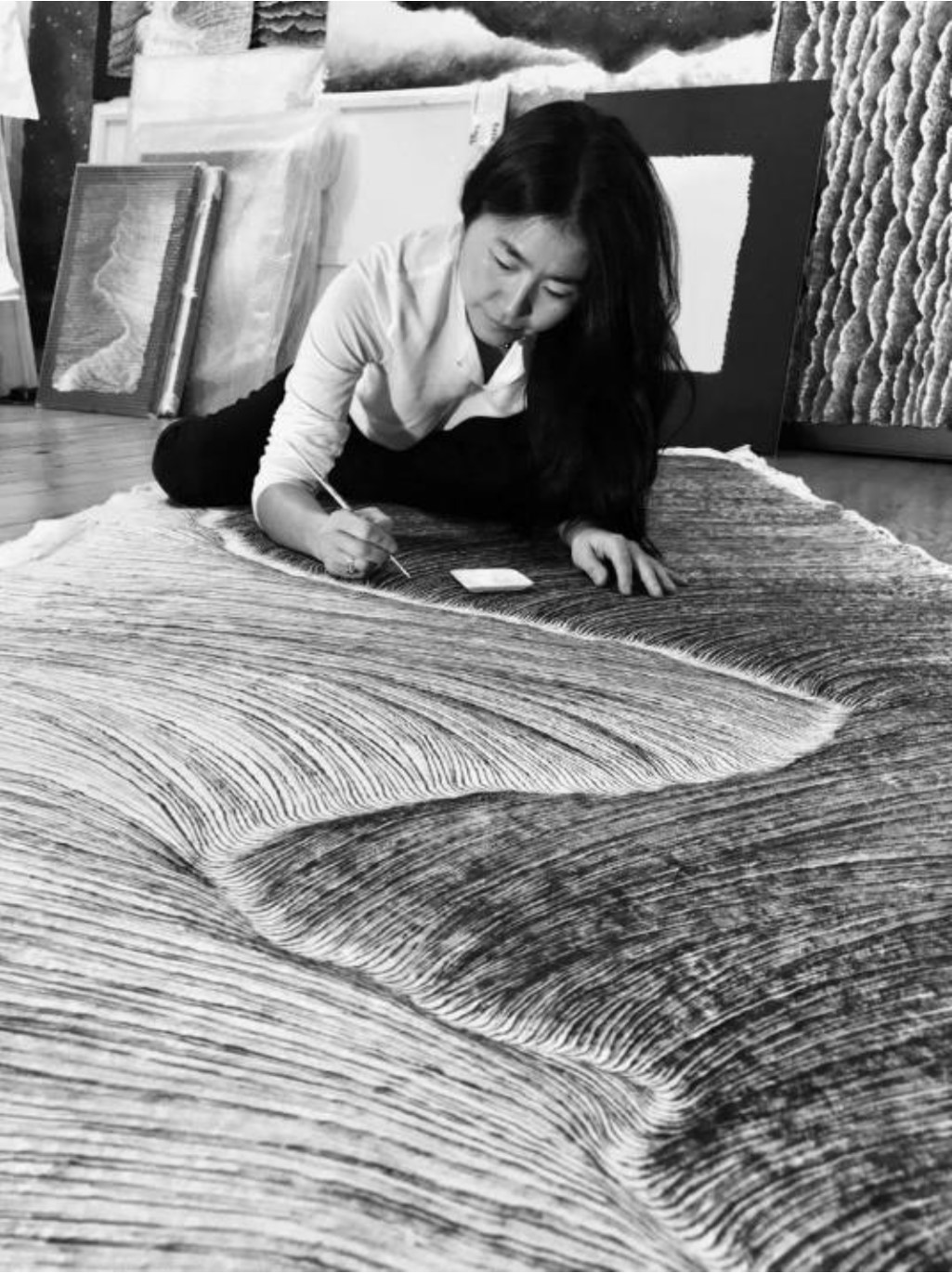Past Exhibition
EnglishABOUT THE ARTIST

Lee Hyun Joung
(b.1972- Korea)
A graduate in visual arts from Sejong University in South Korea, Lee Hyun Joung develops a series of ink landscapes based on memories of her native country, which she mixes with dream projections of vast, unreal places. The single horizon line is replaced by a multitude of parallel and sinuous lines, which split and accumulate like geological strata or sediment ripples, giving a reading grid to these aerial views without scale or proportion.
Abstracted from the artist's personal journey to have a more universal scope. Almost exclusively blue or black, the ink is also writing, which Lee Hyun Joung deploys on hanji sheets, popular Korean papers made from mulberry pulp. In Korea, hanji paper is traditionally used for calligraphy, wallpapering the walls and windows of the house, and making objects. Mulberry leaves are immersed in water, kneaded, dried, cut and the scraps are reintegrated to shape other leaves of which the artist preserves the irregularity and thickness of the fibres. The resulting support is a material-palimpsest, like shreds of memory accumulated to form a blanket.
Tending towards abstraction, detail is evacuated in favour of the sensation of infinity and the uncertain nature of the element represented : a wave could just as easily be a mountain. Between each uninterrupted line, the blank space left vacant on the paper is not an inactive blank space. It corresponds to the idea, widely held in Taoist thought of emptiness and fullness, that the interval is what makes the connection between visible objects. And it is precisely after a period of silence, points out Lee Hyun Joung, that a line emerges : something happens against a background of nothing. The lines, created to the rhythm of her body, are superimposed like musical staves or the ripples of the foreshore left by the low tide : they swell and recede like a breath. Lee Hyun Joung likens these forms to a path of life, an initiatory walk that is less a matter of a delimited stage than of a cyclical time, the one the Greeks called aiôn. Like the nature (desert, land, sea) to which it refers, each line drawn in ink tends to be generic, i.e.
Abstracted from the artist's personal journey to have a more universal scope. Almost exclusively blue or black, the ink is also writing, which Lee Hyun Joung deploys on hanji sheets, popular Korean papers made from mulberry pulp. In Korea, hanji paper is traditionally used for calligraphy, wallpapering the walls and windows of the house, and making objects. Mulberry leaves are immersed in water, kneaded, dried, cut and the scraps are reintegrated to shape other leaves of which the artist preserves the irregularity and thickness of the fibres. The resulting support is a material-palimpsest, like shreds of memory accumulated to form a blanket.
Tending towards abstraction, detail is evacuated in favour of the sensation of infinity and the uncertain nature of the element represented : a wave could just as easily be a mountain. Between each uninterrupted line, the blank space left vacant on the paper is not an inactive blank space. It corresponds to the idea, widely held in Taoist thought of emptiness and fullness, that the interval is what makes the connection between visible objects. And it is precisely after a period of silence, points out Lee Hyun Joung, that a line emerges : something happens against a background of nothing. The lines, created to the rhythm of her body, are superimposed like musical staves or the ripples of the foreshore left by the low tide : they swell and recede like a breath. Lee Hyun Joung likens these forms to a path of life, an initiatory walk that is less a matter of a delimited stage than of a cyclical time, the one the Greeks called aiôn. Like the nature (desert, land, sea) to which it refers, each line drawn in ink tends to be generic, i.e.
